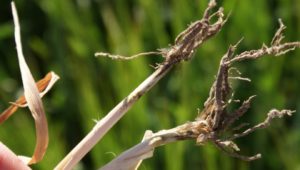Spring barley disease management tailored to 2019
15 May 2019Spring barley this year is coping with some stressful conditions – since brairding temperatures have rocked between summer highs of 20oC plus and single digit lows and some drying winds. There was heavy rain in some areas after drilling and now very dry conditions are common, particularly in the north east. Some stress spotting is evident on lower leaves – you can differentiate this from ramularia as it doesn’t go right through the leaf and isn’t bounded by the veins. There is no need to treat for ramularia this early in the season – it is more of a risk late season and early in crop growth it is particularly rhynchosporium which is the main concern. Rhynchosporium is hard to eradicate once established and so spring barley crops are usually treated protectantly just prior to stem extension to keep the disease out. But with pressures to reduce input costs and to work in more integrated and sustainable ways is there scope to reduce fungicide inputs in the spring crop?
Rhynchosporium, when severe, will take out side tillers and reduce the number of potential grain sites the crop will set so ultimate yield potential is reduced. It will also stress the crop and increase the chances of late season ramularia, particularly where eradicant fungicides have to be deployed to manage the rhynchosporium infection as chemistry can stress the crop in the wrong conditions. The risk of rhynchosporium can be reduced through the use of T1 fungicides but with more resistant varieties and a trend for drier springs then the risk of significant rhynchosporium is reduced so there is some scope to reduce early season inputs in lower risk crops. Leaving crops totally unprotected is risky though and reduced doses and simpler mixes give a sensible middle ground for low risk crops.
Eyespot is often overlooked in spring cereals but poor grain fill has been a feature in affected spring crops over the last two seasons. Eyespot may have been favoured by a pattern of warmer springs, and although spring crops are at lower risk of the disease compared to winter crops, they don’t get away totally free of risk. Many barley fungicide actives will have some eyespot efficacy, particularly cyprodinil, SDHI and prothioconazole based treatments.
This will be our last season with chlorothalonil as an option to manage ramularia later in the season. It is the only effective fungicide to manage the disease and the best timing is at booting to very early ear emergence. Flowering and senescence are the major triggers of the symptoms, but other stresses also play a part and include bursts of sunshine, fluctuations in temperature, nutrient deficiencies and the presence of other foliar diseases. Sprays need to be on ahead of ramularia symptoms appearing on final leaves one and two and have to persist for long enough to keep the crop green well into grain fill. This is why booting is the best compromise timing – aiming the spray at flag leaf emergence is often too early and not the best approach. The ‘midway’ flag leaf timing between T1 and T2 is often too late for early protection and too early for ramularia and late season greening.
Fiona Burnett SRUC, for the Farm Advisory Service
Sign up to the FAS newsletter
Receive updates on news, events and publications from Scotland’s Farm Advisory Service

